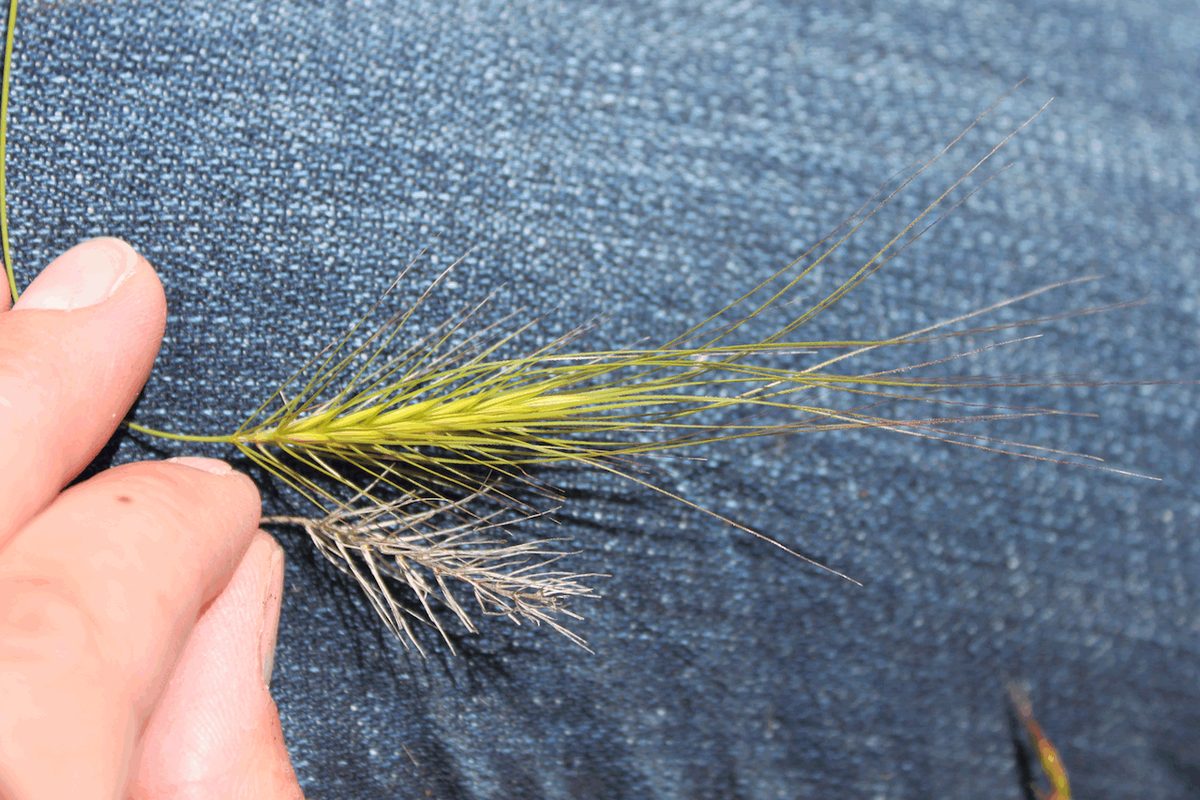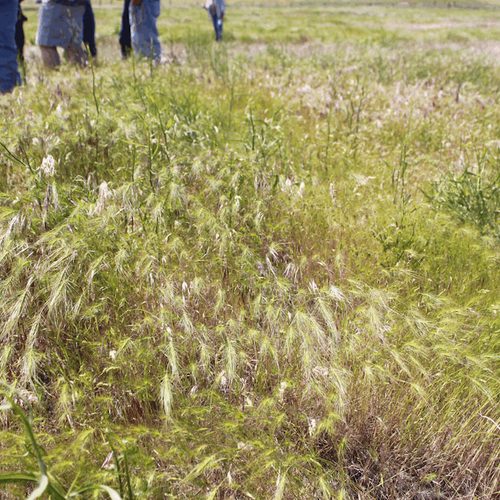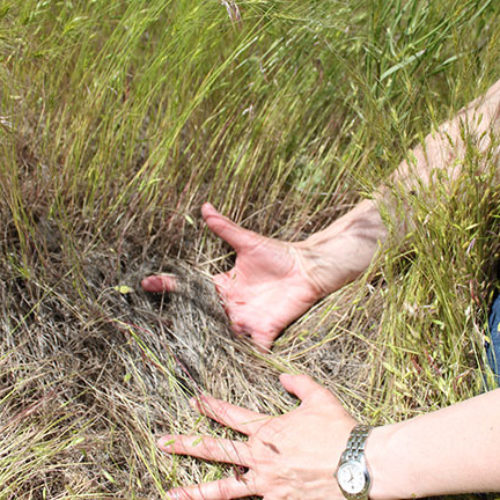Medusahead
Taeniatherum caput-medusae

Family: Poaceae
Other Common Names: medusahead, medusahead wildrye, medusahead rye
Weed class: C
Year Listed: 2016
Native to: Mediterranean region, parts of Asia, Europe, and North Africa
Is this Weed Toxic?:
not known to be
Legal listings:
Medusahead was listed as a Class B noxious weed in Washington State in 1988 and 1989.
Why Is It a Noxious Weed?
Medusahead causes many detrimental impacts where it invades, including the alteration of an ecosystem to favor its own survival and competing with and reduction of native and forage plants, resulting in the degradation of wildlife habitat. Medusahead is a highly competitive species. Its roots grow through the fall, winter and spring, depleting upper soil moisture early in growing season and seedlings have a higher growth rate than native grass seedlings, allowing it to have an advantage acquiring soil resources, even under low nutrient conditions. Its invasion is associated with significant reductions in native vegetation and plant diversity. The silica content of medusahead slows the decomposition of the old plant parts, resulting in the formation of thick, persistent layer of thatch which alters soil temperature and moisture dynamics, limiting the germination of other species. The thatch layer also provides and increases the amount of fine fire fuels, resulting in an increased frequency of fire.
How would I identify it?
General Description
Medusahead, is a nonnative, winter annual grass that can grow up to 2 feet (60 cm) tall. Plants bloom in the spring after many other nonnative annual grasses. Inflorescences are a dense spike with long awns that can be somewhat spreading and twisting, and are covered in small barbs. The mature spike with its spreading awns is said to roughly resembling medusa’s head, hence its common name.
Flower Description
Inflorescences are erect spikes with long awns, with long awns and sessile spikelets. When mature, they often bend in an almost horizontal position. As the awns dry and turn tan, they may twist and spread, reminiscent of the snake-covered head of Medusa.
Leaf description
Plants have open leaf sheaths which may be covered with soft short hairs. Leaves are rolled while in bud and later are flat to inrolled. Leaves may be glabrous (smooth and hairless) or covered with short hairs.
Stem description
Medusahead stems, called culms, grow up to 2.3 feet tall. The thin culms have 3-6 nodes and evenly distributed leaves.
Fruit Seed Description
The fruit is a narrowly elliptic caryopsis, 0.16 to 0.22 inches (4 to 5.2 mm) long, with an adaxial groove and pubescent apex. The caryopsis has small barbs of silica.
May Be Confused With
Medusahead is sometimes confused with Hordeum or Elymus species like foxtail barley, Hordeum jubatum, or squirreltail, Elymus elymoides. Hordeum and native Elymus species have 5-veined lemmas (compared to medusaheads 3-veined lemmas) and their main spike axes typically break apart in fruit (while medusahead spikes does not). Medusahead matures later than other annual grasses, so it can often be recognized by its green color when other grasses have turned brown.
Where does it grow?
It is a well-known rangeland invader and grows in a variety of conditions. Medusahead thrives on soils with a high content of clay and where deep soil moisture is available late growing season. It will also grow on loamy soils and is less of an invader but can be found on well-drained, sandier soils. Please click here to see a county level distribution map for medusahead in Washington.
How Does it Reproduce?
Medusahead reproduces by seed. Most seeds appear to be viable for up to 2 years and seed production can be as high as 243 million seeds per acre. The awns attached to seeds are covered in barbs and readily adhere to fur/hair, clothing, and other materials.
How Do I Control It?
General Information
Medusahead Management Guide for the Western States is a recent publication that provides in-depth and updated recommendations for medusahead management. Controlling medusahead will usually include a combination of control methods and the establishment of a desirable, competitive plant community. Tables detailing possible integrated weed management plans can be found in the guide.
Manual/Mechanical Control
Individual plants and small infestations can be effectively hand-pulled or removed with a hoe. Remove plants when they are large enough to identify but before they have set seed. While hand removal is selective, it is only practical on a very small scale. Mowing low-elevation sites in the late spring, when flowering has begun (emergence of awns to emergence of floret anthers) but prior to seed development, can provide effective control. Mowing is generally not as successful for high-elevations sites given the difficulty of access, fuel costs, rough terrain and the native plant communities that may not respond well to being mowed. Early-season mowing may harm other species and not effectively control medusahead while mowing later in the season, when inflorescences are just starting to form to early flowering stage, can be effective. Do not mow after seeds have matured as it will just help disperse the seed. Evaluate your landscape to see if tillage would be a good management option. Cons to tillage include potential soil erosion, loss of organic matter and soil moisture and loss of microbiotic crusts. Pros to tillage include control of medusahead plants, burying seed, breaking up medusahead thatch that can prevent other plants from growing, and prepping a site for reseeding. Tillage can be used for medusahead control where the terrain permits and where it will not detrimentally harm desired existing plant communities, like sagebrush steppe, which are not adapted to deep tillage. It is important to follow up tillage with reseeding. Removing thatch by harrowing can prep a site for reseeding or a preemergent herbicide, but it does not control existing medusahead plants.
Cultural Control
Controlled burns can reduce infestations, though burn conditions and timing are important as in some cases fire can enhance plant populations. Maintaining and establishing a healthy, vigorous resident plant community is critical when controlling and preventing medusahead infestations. Medusahead is more competitive in the seedling stage than perennial bunchgrasses, so successful control of medusahead is often needed first before establishment of desired vegetation. Also, medusahead thatch will need to be reduced or removed for most desirable species to establish. If possible, wait for initial control methods to provide some control of medusahead plants and thatch, and then follow with the seeding of desired plants species. Seeding a mix of annual and perennial species may provide a competitive plant community at sites where medusahead control is taking place. Although it is often desirable to seed with native species, they can be more difficult to establish and nonnative, non-invasive species may be used instead for revegetation.
Biological Control
There are currently no approved biological control agents for medusahead but research is ongoing. Naturally occurring soil bacteria have been found to be suppressive to medusahead and other nonnative annual grasses cheatgrass (Bromus tectorum) and jointed goatgrass (Aegilops cylindrical). Currently research and testing of a native rhizobacterium, Pseudomonas fluorescens strain D7 (Pf D7) is underway as it is showing promise in reducing medusahead infestations. At its early stages, medusahead is palatable and its protein content is comparable to other annual grass species. Grazing plants at this stage is desirable as it will help prevent plants maturing and developing seed. As it ages, medusahead accumulates silica and becomes less palatable, and animals eventually avoid grazing it. Grazing with sheep can provide control benefits, with high density, short duration, mid-spring grazing providing good control on a California grassland. Cattle may also provide some control with similar timing.
Herbicide Control
A challenge with herbicide use is to selectively control medusahead without damaging desirable plants and also the cost of large-scale control. See Chapter 7 of Medusahead Management Guide for the Western States for detailed information on herbicide use, timing, treatment considerations, and rates. The Pacific Northwest Weed Management Handbook has some information on medusahead control; look under the headings for imazapic and imazapic + glyphosate. Always read and follow the herbicide label instructions. Check with your local county noxious weed coordinator to discuss treatment options.
For More Information
Please see our written findings for more information on medusahead.
National Invasive Species Information Center information on medusahead
Images from UW Herbarium's image database






